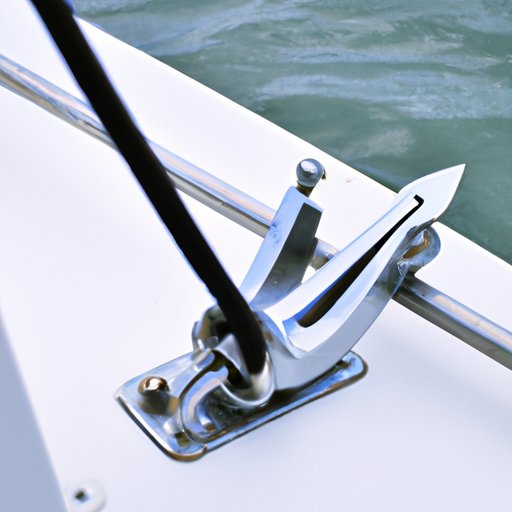Introduction
An anchor is an essential piece of equipment for any boat, allowing it to stay securely in place even in rough waters. But just how does an anchor work? This article will explore the physics behind the forces that keep a boat in place, compare and contrast traditional and modern anchors, and discuss the importance of proper anchoring techniques.

Explaining the Physics of How an Anchor Holds a Boat in Place
The forces that keep a boat in place when an anchor is deployed are the result of two simple physical principles: friction and tension. When an anchor is dropped, the flukes dig into the seabed and create friction, which helps to hold the boat in place. The tension created by the rope or chain that connects the boat to the anchor also helps to keep the boat in place, as the tension keeps the anchor firmly planted in the seabed.
There are several different types of anchors that can be used depending on the conditions and the needs of the boat. For example, a plow-style anchor is best suited for sandy bottoms, while a mushroom anchor is better for muddier environments. There are also various types of anchors designed for specific uses, such as mooring anchors or drift anchors.
Comparing and Contrasting Traditional and Modern Anchors
Traditional anchors are typically made from heavy materials such as iron, steel, or lead, and they have been used for centuries. These anchors are designed with a curved shape that allows them to dig into the seabed and create friction, helping to hold the boat in place. They are also designed to be relatively lightweight and easy to deploy, making them ideal for smaller boats.
Modern anchors, on the other hand, are typically made from lighter materials such as aluminum or composite materials. They are designed differently than traditional anchors, with a more streamlined shape that reduces drag and makes them easier to deploy. They are also designed to be more efficient at digging into the seabed, allowing them to hold boats more securely in place.
Each type of anchor has its own advantages and disadvantages. Traditional anchors tend to be more durable, but they are heavier and more difficult to deploy. Modern anchors, meanwhile, are lighter and easier to deploy, but they may not be as effective in certain environments.

Exploring the History of Anchors and Their Evolution
Anchors have been used since ancient times, with early examples dating back to the 4th century BC. Over the centuries, anchors have evolved from large, heavy stones to the metal anchors used today. In more recent years, there have been various innovations in anchor design, such as the introduction of modern materials and the development of more efficient shapes.

Discussing the Challenges of Using Anchors in Different Environments
Using an anchor effectively requires an understanding of the local environment. Different types of seabed require different types of anchors, and certain weather conditions can make it more difficult to set and secure an anchor. For example, strong currents can make it difficult to set an anchor, while shallow water can reduce the effectiveness of some types of anchors.
Explaining the Importance of Proper Anchoring Techniques
It is important to prepare carefully before setting an anchor. This means researching the local environment, choosing the right type of anchor for the conditions, and making sure the anchor is properly set and secured. Without careful preparation, it is possible for an anchor to become dislodged, which can be dangerous for the boat and the crew.
Outlining the Steps for Setting up an Anchor Correctly
To set up an anchor correctly, there are several steps that need to be taken. First, the boat must be positioned in the right spot, taking into account factors such as wind direction and current strength. Next, the appropriate type of anchor should be chosen, taking into account the type of seabed and the size of the boat. Finally, the anchor should be set and secured, using either a rope or a chain, depending on the conditions.
Conclusion
Anchors are essential pieces of equipment for any boat, allowing it to stay securely in place even in rough waters. This article has explored the physics behind the forces that keep a boat in place when an anchor is deployed, compared and contrasted traditional and modern anchors, and discussed the importance of proper anchoring techniques. Finally, it has outlined the steps for setting up an anchor correctly, emphasizing the need for careful preparation and an understanding of the local environment.
(Note: Is this article not meeting your expectations? Do you have knowledge or insights to share? Unlock new opportunities and expand your reach by joining our authors team. Click Registration to join us and share your expertise with our readers.)
